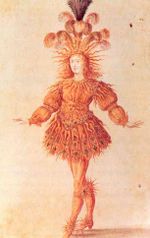Ancien Régime
Kingdom of France |
|---|
| Structure |
|
Parlements French nobility Taille Gabelle Seigneurial system |

Ancien Régime (French pronunciation: [ɑ̃sjɛ̃ ʁeʒim]) refers primarily to the aristocratic system that characterized French society and politics established in France under the Valois and Bourbon dynasties from the 14th century to the 18th century. It was overthrown by the French Revolution.[1]
Contents |
Terminology
The term is French for "Former Regime," but rendered in English as "Old (or Ancient) Regime", "Old Order," or "Old Rule". The term dates from the Age of Enlightenment (first appearing in print in English in 1794) and was originally pejorative in nature. Similar to other sweeping criticisms of the past, such as the consciously disparaging term Dark Ages for what is more commonly known as the Middle Ages, ancien regime was not a neutral historical descriptor. It was created by the French Revolutionaries to promote their cause, coloring pre-revolutionary society with disapproval and implying approval of a "New Order".
The analogous term "Antiguo Régimen" is often used in Spanish. However, although Spain was strongly affected by the French Revolution and its aftermath, the break was not as sharp as in France.
More generally, ancien régime refers to any political and social system having the principal features of the French Ancien Regime. Europe's other anciens régimes had similar origins, but diverse fates: some eventually evolved into constitutional monarchies, whereas others were torn down by wars and revolutions.
Ancien Régime in France
Society and population
The Ancien Régime covered a territory of around 200,000 square miles (500,000 km2) in 1700, could support around 20 million people and at least four fifths of the population were peasants.[2] There was no nationwide census before 1789 and therefore these figures are estimates.[3]
France had the second largest population in Europe around 1700[4] but this advantage began to fade during the 18th century, with the European population growing faster than the French. France's first real experiment with conscription was after the Regime (In 1798) and led to an unprecedented military superiority compared to her European neighbors.[5]
Power
Power in the Ancien Régime relied on three pillars: the monarchy, the clergy, and the aristocracy. Society was divided into three Estates of the realm: the First Estate, Catholic clergy; the Second Estate, the nobility; and the Third Estate, the rest of the population.[6]
The Ancien Régime retained many aspects of a feudal system that had existed since at least the 8th century, in particular noble and aristocratic privilege, and was supported by the doctrine of the Divine Right of Kings. It differed from that earlier feudal order in that political power had increasingly become concentrated in an absolute monarch.
Nostalgia
For some observers the term came to denote a certain nostalgia. Talleyrand famously quipped:
| “ | Celui qui n'a pas vécu au dix-huitième siècle avant la Révolution ne connaît pas la douceur de vivre[7]: ("Those who have not lived in the eighteenth century before the Revolution do not know the sweetness of living") | ” |
The reason for this affection was the perceived decline in culture and values following the Revolution, where the aristocracy lost much of its economic and political power to what was seen as a rich, but coarse and materialistic bourgeoise. The theme recurs throughout nineteenth-century French literature, with Balzac and Flaubert alike attacking the mores of the new upper classes. To this mindset, the Ancien Régime expressed a bygone era of refinement and grace, before the Revolution and its associated changes disrupted the aristocratic tradition and ushered in a crude, uncertain modernity.
The historian Alexis de Tocqueville argued against this defining narrative in his classic study, highlighting the continuities between pre- and post- revolutionary French institutions.
Further reading
- Doyle, William. Old Regime France: 1648-1788 (2001) excerpt and text search
- Goubert, Pierre. Louis XIV and Twenty Million Frenchmen (1972), social history from Annales School
- Jones, Colin. The Great Nation: France from Louis XV to Napoleon (2002) excerpt and text search
- Le Roy Ladurie, Emmanuel. The Ancien Regime: A History of France 1610 - 1774 (1999), survey by leader of the Annales School excerpt and text search
- Lynn, John A. The Wars of Louis XIV, 1667-1714 (1999) excerpt and text search
- Wolf, John B. Louis XIV (1968), the standard scholarly biography online edition
References
- ↑ Doyle (2001)
- ↑ Pierre Goubert, The Ancien Regime (1973) pp. 2-9
- ↑ France lagged behind most of Europe in this regard; Spain and Sweden held censuses in 1717 and 1720 respectively
- ↑ England had about five million, Spain had around eight million and the Austrian Habsburgs had around eight million. Russia was the most populated European country at the time.
- ↑ Goubert, Louis XIV and Twenty Million Frenchmen (1972)
- ↑ Emmanuel Le Roy Ladurie, The Ancien Regime: A History of France 1610 - 1774 (1999)
- ↑ "Celui qui n'a pas vécu au dix-huitième siècle avant la Révolution ne connaît pas la douceur de vivre et ne peut imaginer ce qu'il peut y avoir de bonheur dans la vie. C'est le siècle qui a forgé toutes les armes victorieuses contre cet insaisissable adversaire qu'on appelle l'ennui. L'Amour, la Poésie, la Musique, le Théâtre, la Peinture, l'Architecture, la Cour, les Salons, les Parcs et les Jardins, la Gastronomie, les Lettres, les Arts, les Sciences, tout concourait à la satisfaction des appétits physiques, intellectuels et même moraux, au raffinement de toutes les voluptés, de toutes les élégances et de tous les plaisirs. L'existence était si bien remplie qui si le dix-septième siècle a été le Grand Siècle des gloires, le dix-huitième a été celui des indigestions." Charles-Maurice de Talleyrand-Périgord: Mémoires du Prince de Talleyrand: La Confession de Talleyrand, V. 1-5 Chapter: La jeunesse - Le cercle de Madame du Barry.
|
|||||||||||||||||||||||||||||||||||||||||||||||||||||||||||||||||||||||||||||||||||||||||||||||||||||||||||||||||||||||||||||||||||||||||||||||||||